Creator Campaings
Discover +10 Million creators across all industries and niches.
Get Al-Powered and activable insights around creator's profiles.
Manage influencers effortlessly at one place.
Reach out to millions of creators directly on the platform.
Social Media Insights
Favikon for Creators
Grow as a creator on social media
Grow
Get Noticed
Blogs Articles
Methodology & Rankings
About Favikon, rankings, tools & much more.
Methodology
The recipe behind Favikon's viral & coveted rankings.
Free tools to power your influencer marketing workflows.
The people & mission that fuels Favikon.
Get access to all Favikon rankings.
Become a select Favikon Partner
Become a select Favikon Affiliates
Featured Rankings
Highlighting the most influential creators on X, shaping global conversations and trends
Showcasing top creators in the sales niche, driving innovation and engagement across the U.S.
Recognizing global leaders on LinkedIn for their impactful thought leadership and professional insights.
The place to talk creator economy, together


The Unique Benefits of Influencer Marketing (How it’s Different)
Is influencer marketing worth the investment? Wouldn’t it be easier to just run paid ads? Here are the unique benefits of influencer marketing that other channels can’t offer.
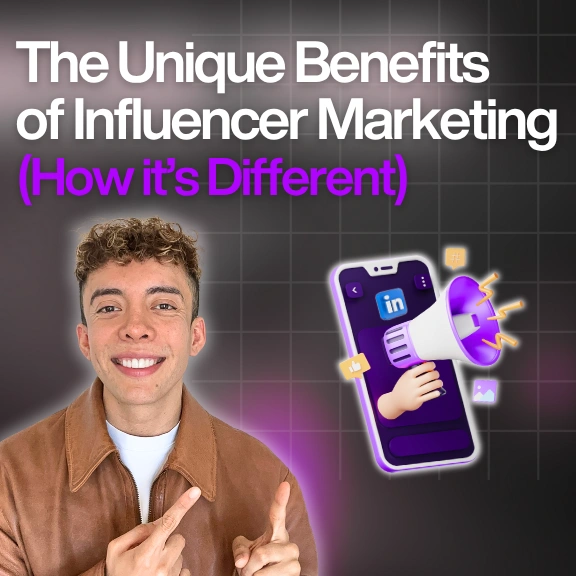


Megan Mahoney is an influencer marketer who uses data and real-world case studies to uncover what actually drives results in influencer campaigns. With a background in content marketing and over a decade of experience helping brands grow through strategy and storytelling, she brings a thoughtful perspective to creator partnerships and is deeply engaged in the evolving creator economy.
Check Brand DealsThe Unique Benefits of Influencer Marketing (How it’s Different)
Is influencer marketing worth it?
It’s a valid question.
Influencer outreach and negotiation is time consuming and you have very little control over campaign performance.
At the end of the day, you’re dealing with people, making it much more complex than traditional paid ads.
Yet there are plenty of companies (both B2C and B2B) investing millions in influencer marketing.
I asked a handful of influencer marketers about the unique benefits of influencer marketing, and in this post, I’ll share their perspectives.
And, I’ll share when it doesn’t make sense to invest in influencer marketing.
Creators (Especially in B2B) Are Often Underpriced
Right now, many creators are undercharging for the value of their influence.
However, I include this point separately from the other seven unique benefits of influencer marketing, because I do not believe it will hold true into the future. (Whereas the other seven unique benefits mentioned in this post will remain true into the future.)
Any effective marketing channel eventually becomes saturated and prices will increase.
However, that doesn’t mean that you shouldn’t take advantage of this undervalued channel while it lasts.
To give you an idea of just how undervalued influencer marketing is, consider these case studies.
I recently wrote a case study about a LinkedIn influencer marketing campaign that generated $1.1 million in pipeline from a $12,000 investment.
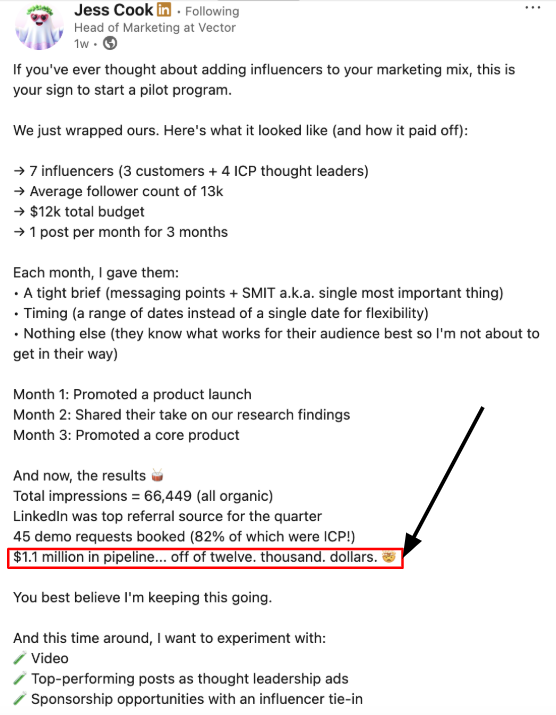
I also saw the Head of Marketing at Storylane post that influencer marketing is generating $X CPMs versus the standard $X CPMs, and they plan to push their budget to $1 million if performance continues.

Finally, Chrsitina Pearo of Slate also mentioned that influencer marketing has been Slate’s top performing marketing channel.
“It's been incredible for us. It's done more for us than any paid, organic strategies ever done,” says Christina.
However, even as influencer pricing increases, these are seven benefits unique to influencer marketing that will continue to hold true into the future.
#1: Brand Credibility and Trust
Most companies have competitors selling very similar products.
As a consumer, you’ll probably just choose the one that a person you trust recommends.
This is true if you’re selecting project management software or a protein bar.
Influencer campaigns are the easiest way to essentially scale personal recommendations.
This is a key reason why Sean of Ridge Wallet invests heavily in influencer marketing:
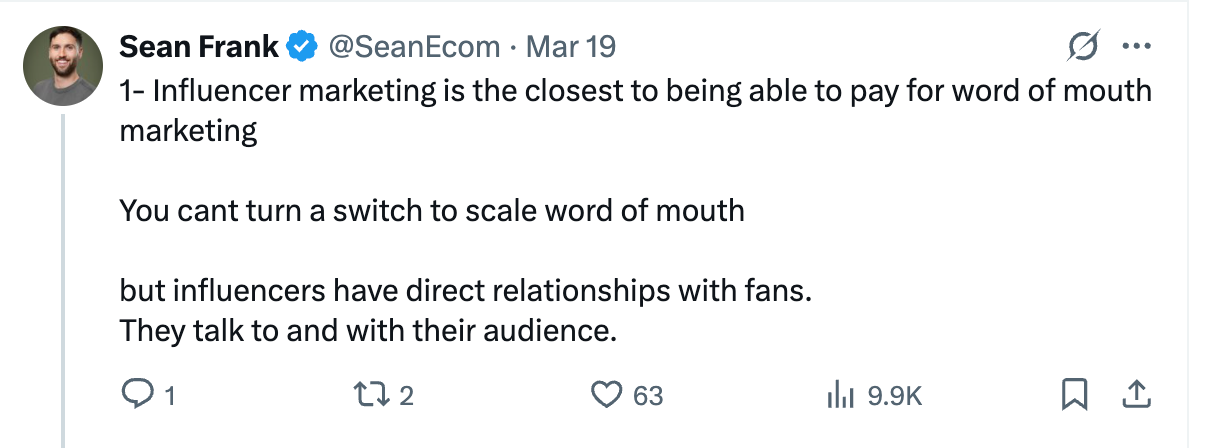
When I spoke with Ash Turner of Synthesia, he echoed Sean’s thoughts:

He also shared this analogy:

He shared that the same is true for B2B companies as most SaaS products are similar:

Additionally, if you have plenty of influencers promoting your product, there’s a certain level of trust that your company is legitimate.
This is particularly important if you’re a newer startup and need to prove that your company is more than just a landing page.
#2: Organic Influencer Mentions
Jeremy Barabara introduced the idea of “influencer cross pollination” where other influencers create content about your product simply because they see other influencers reviewing it.

There are a few reasons why influencer cross pollination occurs:
- You’ve made your brand a trending topic, and influencers know that content centered around current trends tends to perform well.
- The sponsored reviews create demand for unsponsored content reviewing your product. Therefore, these creators see unsponsored reviews as a content opportunity.
For example, think about HelloFresh. They’ve sponsored dozens of creators.
As a result, you’ll see that many influencers have created their own unsponsored HelloFresh reviews because:
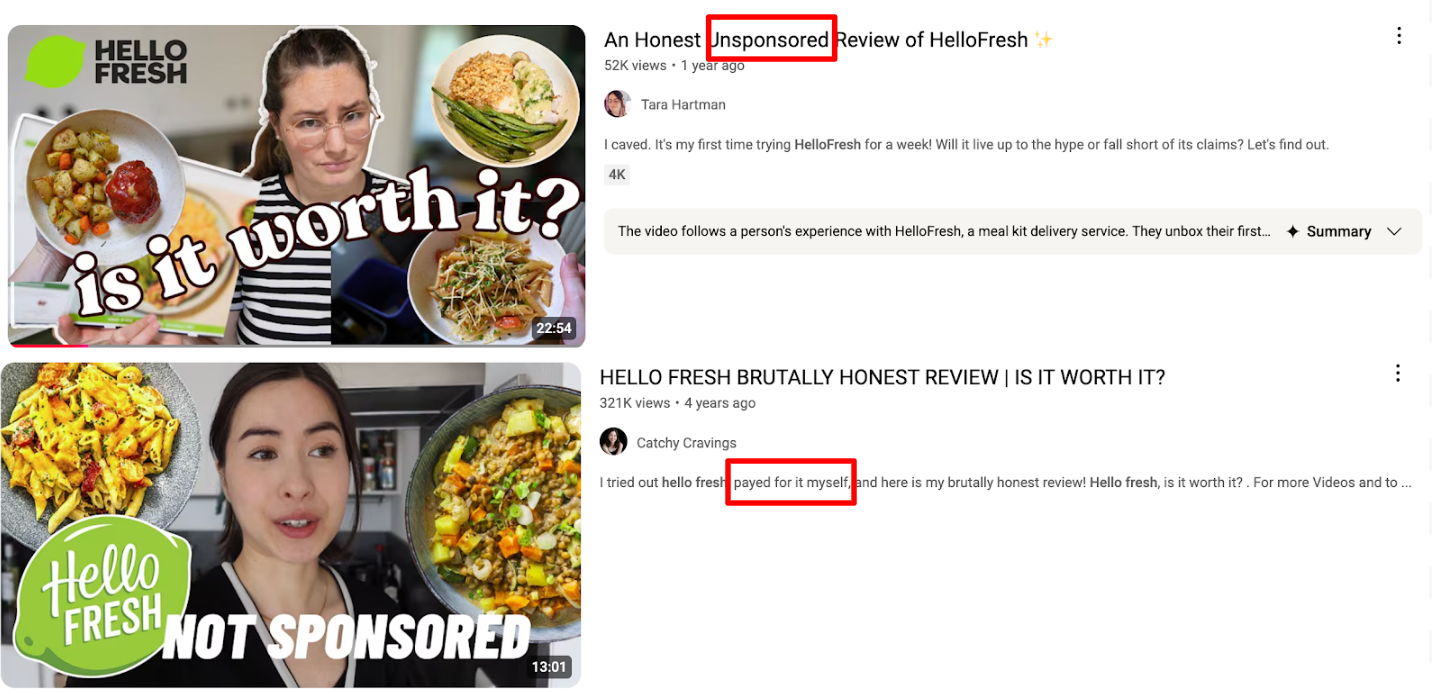
Of course, the caveat here is that your product needs to actually be high quality. Otherwise, you’ll just have a lot of negative reviews.
#3: SEO and LLM Visibility
Ranking text based blog posts organically in Google is becoming increasingly difficult, especially if your website has low or moderate domain authority.
For example, “best project management software” is a very competitive keyword.
However, the YouTube search results are less competitive, and Google is showing more and more videos in its traditional text-based SERPs.

So if you sponsor YouTubers to create dedicated videos about your product, you have a much better chance of ranking on the first page of Google and in the YouTube search results.
Additionally, Ahrefs released a study showing that frequency of brand mentions across the web is the top factor that impacts a brand’s presence in LLMs. So the more influencers mentioning your brand across the web, the more likely your brand is to appear in LLMs like ChatGPT.

There are also plenty of influencer marketers confirming that SEO and LLM impact is now a critical KPI.
For example, Sarah Adam of Wix said this:
“Now, in 2025 with LLMs changing the SEO game, we’re working with 50% less YouTubers on highly targeted dedicated videos based on top keywords, i.e what our ICP is actually looking for both on YouTube and LLMs.”

Jeremy Barbara of doola echoed Sarah’s thoughts in this post.
He recommends buying dedicated videos for keywords relevant to your audience.

Additionally, Google’s EEAT guidelines state that the algorithm favors content that shows genuine experience. Creators who have tried your product therefore have a much better chance of ranking in Google than a faceless brand.
Finally, your SEO team only has one shot to write a post to rank first in Google for a keyword.
With influencers, you have endless opportunities to dominate the entire YouTube search results and get your video in the Google search results.
For these reasons, I believe influencer marketing will become increasingly important for SEO and LLM visibility.
#4: Market and Audience Research
Influencer marketing gives you the chance to see how your ICP perceives the value of your product.
Marketers often do some form of customer research to identify their ICP and the ICP’s pain points, but they still don’t always perfectly articulate how customers use the product.
An influencer can solve this problem by explaining to their audience, in their own words, how they use the product and the benefits it provides.
Then, you can then test the messaging crafted by your influencer in paid ads, on your website, and even in the copy in your BOFU blog posts.
For example, Kaylee Edmondson published the below sponsored post for Vector. She highlights exactly how she uses the product and the value she derives from it:

This is useful information, because Vector can use the phrasing “do you know which specific people are seeing your ads?” in its ad messaging.
Additionally, Vector can use this information to improve its SEO, because they should target keywords like “increase linkedin ad engagement.”
For example, I saw this pain point is a major topic on Reddit that Vector could address:
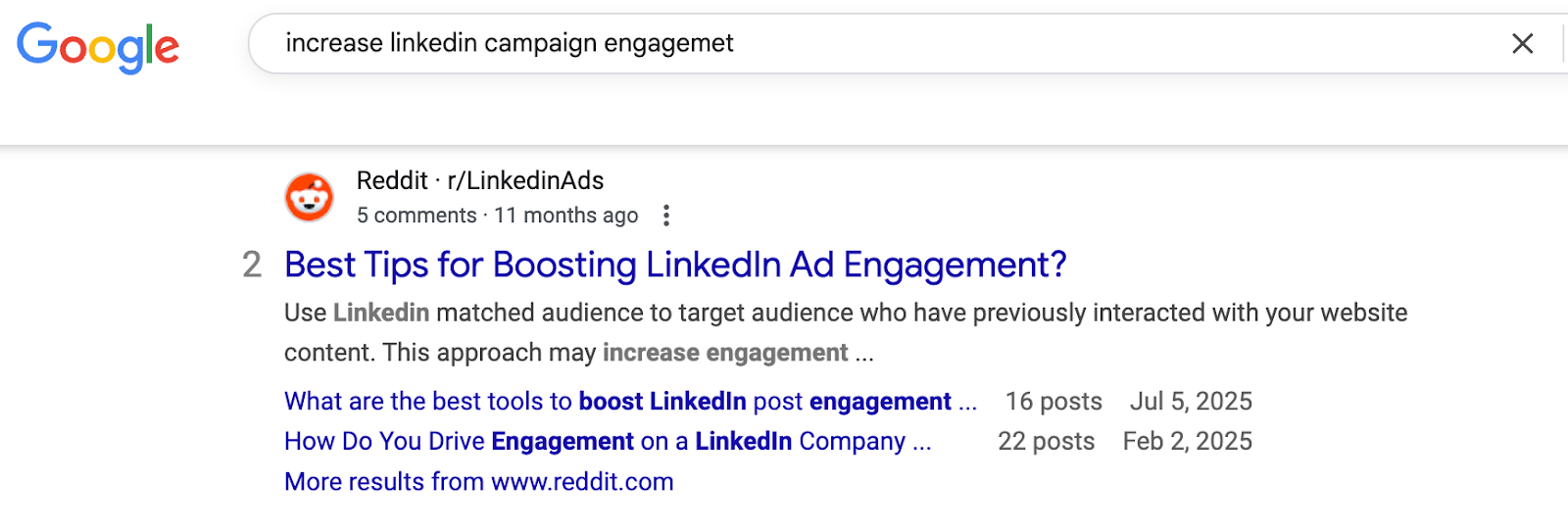
On a related note, there are plenty of SaaS products whose differentiator is simply that it delivers more effectively on the promise.
However, it’s a very hard sell for a SaaS company to convince a prospect that their product is simply “better.”
Yet if an influencer shows that your product is more effective, that’s much more convincing.
For example, one of Vector’s key value propositions is that it de-anonymizes traffic.
Yet influencer Kaylee Edmonson addresses that many products claim to deliver this value but fall short on their promise.
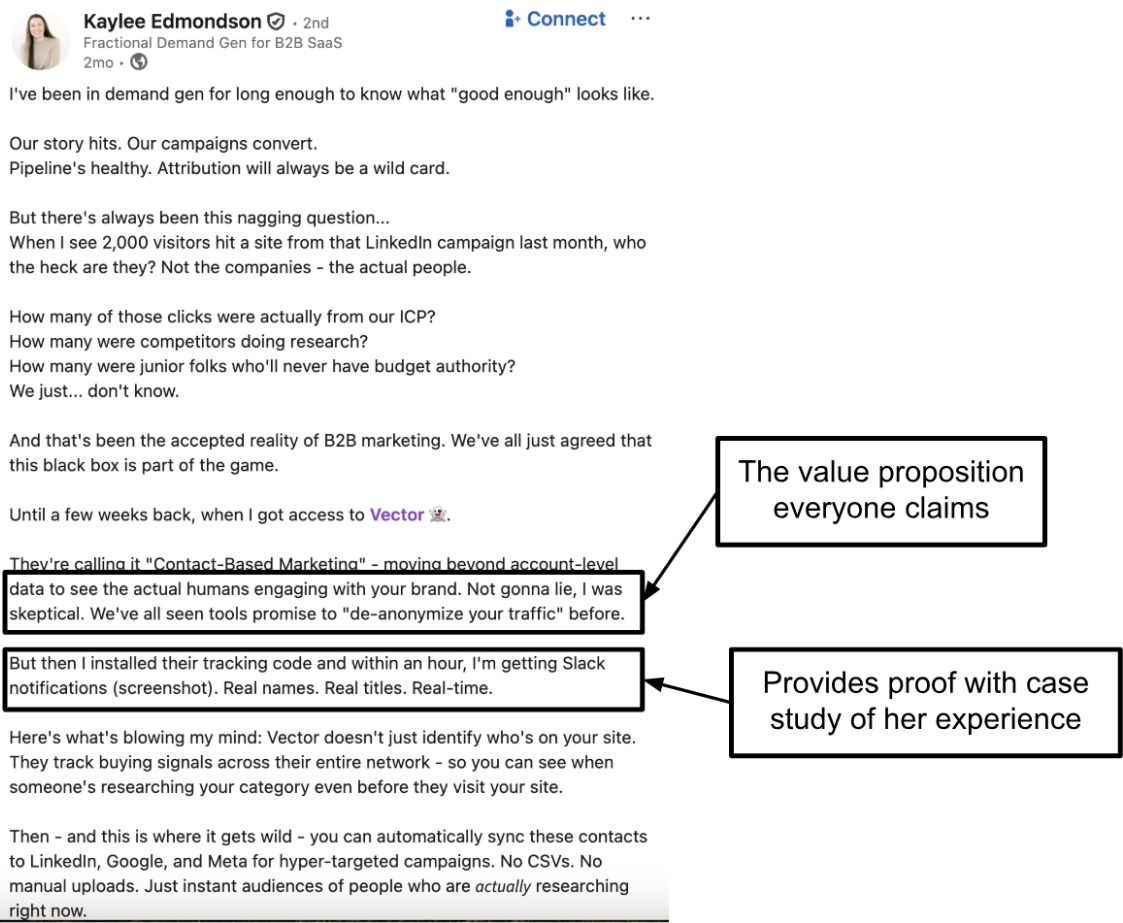
In this post, she not only addresses this objection, but also offers a case study that shows she actually saw great results with Vector.
This makes a much more compelling case for Vector than if Vector itself simply said they’re a more effective tool than other competitors.
#5: UGC Content
If an influencer is posting content about your brand, it will likely also spike UGC content from your general audience.
For example, when Notion launched its Faces campaign, a variety of other people also jumped in and created and posted their own Notion Faces. For example, here’s a post from a creator with over 11,000 followers who organically posted their own Notion Face:
Christina of Slate also mentioned that UGC was an unexpected benefit of their influencer campaigns:

#6: Test New Audiences
Another benefit of influencer marketing is that you can quickly and easily test a new audience.
Jeremy of doola explains that setting up an entirely new ad campaign to test a new audience is costly due to the algorithm’s learning curve, though you can easily test out a new audience by leveraging a few creators in a new niche:
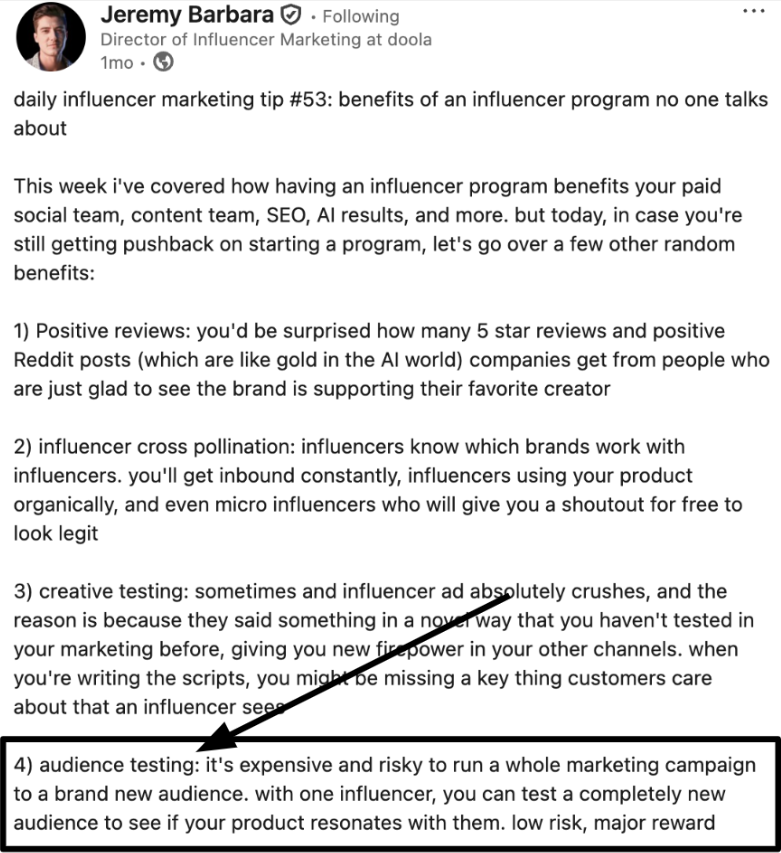
In another post, he refers to influencer marketing as essentially a “sandbox” you can leverage to test new audiences:
For example, Igor Gorbenko of Ahrefs mentioned that they’re working on moving away from positioning the brand as an “SEO tool” and more as a comprehensive marketing suite. Influencer marketing has been useful in helping them reach a relevant new audience:


#7: Targeted Customer Acquisition
I noticed at the bottom of one of Vector’s influencer marketing posts that the influencer themself mentioned they integrated the product into their tech stack:
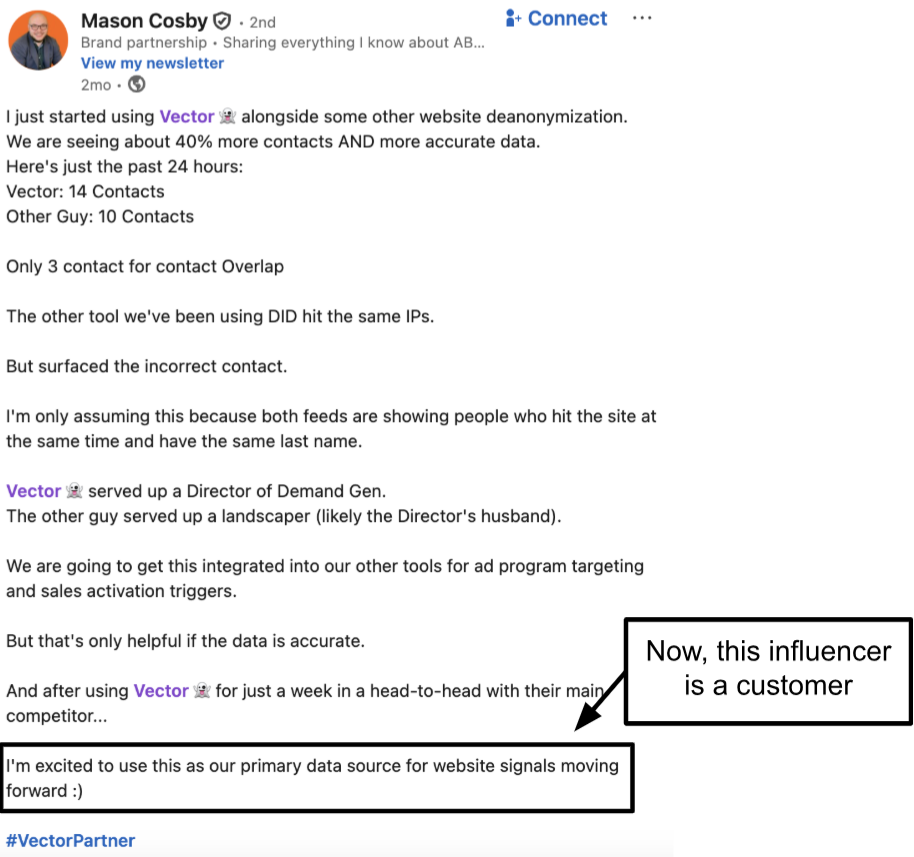
Therefore, Vector acquired the influencer as a customer.
Sure, they initially paid the influencer to try the product and promote it, but now Vector is earning:
- Recurring revenue from that influencer.
- (Potentially) free brand recommendations. If someone asks the influencer about their tech stack, they’ll likely organically mention Vector.
When I spoke with Christina of Slate about her criteria for choosing influencers, she also mentioned this benefit:
“We look for [influencers working at] brands that we would also want to be future clients, because then through the influencer process, they're learning about our product and then eventually hopefully would use our product and become customers.”
Of course, the product itself needs to deliver value, otherwise the influencer (and their audience) will churn.
How to Make Your Influencer Marketing Workflow More Efficient
These are the unique benefits of influencer marketing, but the fact still remains that finding and reaching out to influencers is time consuming.
To make it easier for you to identify the right influencers and streamline communication, we built Favikon.
It allows you to search for influencers on platforms like LinkedIn, X, Pinterest, Instagram, and YouTube. You can sort by average views per post, average engagement, language, and other filters.
Learn more about how Favikon can help you efficiently run a successful influencer marketing campaign.
Related Articles
See all the articles
Find, analyze, and contact top influencers from a 10M+ creator database on Instagram, Linkedin, Youtube, Tiktok, and X to grow your business.
Favikon is an influencer marketing sofware. We are not affiliated, associated, endorsed by, or in any way officially connected with the Tiktok, Youtube, LinkedIn or Instagram brand, or any ot ifts subsidiaries or its affliates. The names "Tiktok", "Youtube", "LinkedIn" and "Instagram" as well as related names, marks, emblems and images are registered trademarks of their respective owners.
Copyright © 2025 Favikon | All Rights Reserved




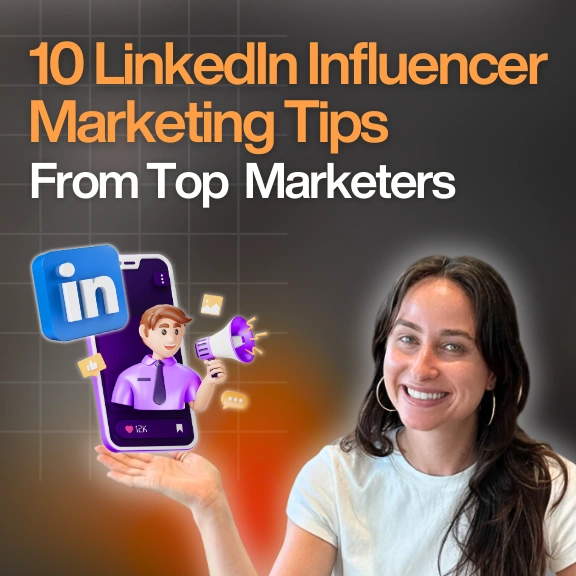
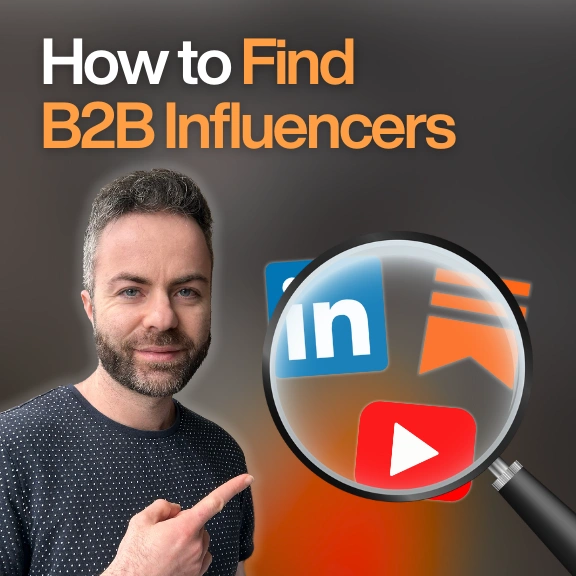








.png)
